

 STUART JORDAN takes us through the history of railways in Switzerland.
STUART JORDAN takes us through the history of railways in Switzerland.
The first railway line in Switzerland was actually French - an extension of the Strasbourg-Basel Railway which reached the Swiss city of Basel in 1844. This was joined a decade later when a branch of the Baden State Railway left that duchy (now part of Germany) and also terminated at Basel. Basel seems to be somewhat of an early focal point of railways as the first internal Swiss line, the Swiss Northern Railway, joined the Baden State Railway linking it to Zurich.
Recognising the expertise of British railway engineers, the Swiss Federal Council asked Robert Stephenson and Henry Swinburne in 1850 to submit plans for a rail network through the difficult terrain of the whole of the Swiss Confederation. It's a testament to their planning that the entire proposed network was eventually built.
Rail policy was decentralised in 1848, with responsibility to create railway policy given to each individual canton. They could invest in projects if they wished, but most railway building was completed by privately owned companies. The network grew based on Stephenson and Swinburne's recommendations.
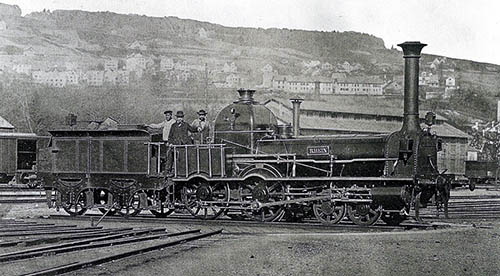
"Rhein" Locomotive at Zurich station in 1867.
Many companies sprung up in the last years of the 19th Century, including the Swiss Central Railway (Schweizerische Centralbahn), the Swiss Northeastern Railway (Schweizerische Nordostbahn, and the West Switzerland Company (Compagnie de L'Ouest-Suisse). As is often the case, other modes of transport were combined with the railways, with a steamship service serving Geneva crossing Lake Geneva and linking with the network - with other lakes running similar services. Various bankruptcies saw the individual Swiss lines consolidating into just a few large companies.
During this period the mechanisation of transport often went hand-in-hand with the mechanisation of war, and learning from the problems of troop movement in the Franco-Prussian War (1870-71) the Swiss government took a bold step - the powers to make railway policy were taken away from the cantons and federalised.
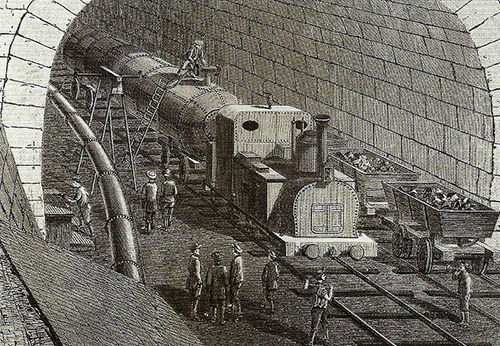
A construction locomotive on the Gotthard Tunnel.
Railway lines through the alpine passes south into Italy were now considered - with the passes at Gotthard, Lukmanier, Simplon, and Splugen investigated. The first was completed in 1882 - the Gotthard Railway including the world's longest railway tunnel at the time. The Swiss army built fortresses at the Swiss end of the tunnel in order to protect from invasion.
The Rhaetian Railway's Albula line and Bernina Railway were completed in the early 1900s. These Metre Gauge railways were originally opened for tourists but were expanded into freight use later on. Many other Narrow Gauge branch lines and mountain railways were also built during this period, the smaller gauge suiting the rugged terrain a lot better.
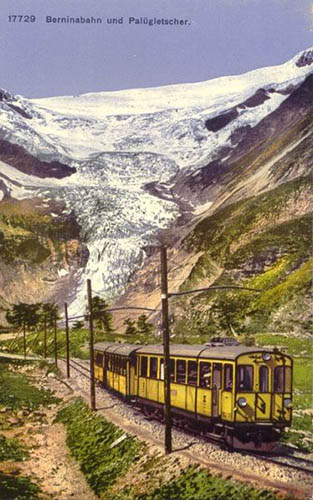
The Bernina Railway around 1910.
Various factors led to support for nationalising the railways - strikes, private rail companies going bankrupt, and anger at foreign ownership of the railways. Several referendums were held, with one in 1898 being decisive - attaining the highest level of voter participation to date. As a result, the Swiss Confederation began buying out the big five railway companies and by 1909 had consolidated them into the Swiss Federal Railways. Modernisation of the lines was the next goal - electrification, doubling of current single lines, and improvement to safety. The coal shortages during the two world wars accelerated electrification, and the Swiss network was far more advanced in this aspect than other European countries.
As was the same in many countries, the post-WW2 motor car boom lead to a decrease in passenger numbers on the railways. Numbers had reduced significantly by the end of the 1960 and the Swiss Federal Railways made changes to make rail travel more attractive. More trains were put on which led to a staggering increase of passenger numbers of 71% between 1971 and 1983. The Taktfahrplan timetable was introduced which made it easier to switch trains - as each train arrives and leaves each station at the same minute past the hour. This meant that (in theory) passengers would never miss a connection.
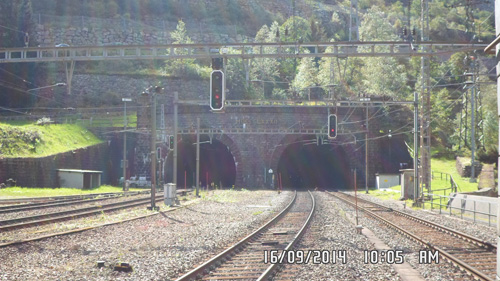
The Swiss-side entrance to the Gotthard Base Tunnel.
Efforts were made across the network to improve the service. Funding was approved in 1996 to upgrade the alpine crossings, with the Lotschberg Base Tunnel opening in 2007 and the Gotthard Base Tunnel opening in 2016 - for more please read, "Cab Riding the Gotthard". A third tunnel at Ceneri is due to be completed in 2020.
Swiss items are available in most of the most popular scales, from many different manufacturers including Piko, Fleischmann, Roco, Kato, Marklin, and Trix.
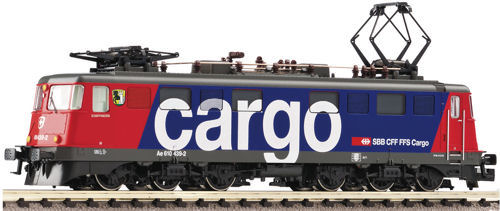
Fleischmann N Scale SBB Cargo Ae6/6 Electric Locomotive
Regarding the main companies in Switzerland, you can find details of SBB, RhB, and BLS products on the links provided.